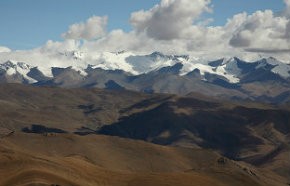The great exhale: CO2 and the extinction of species

Atmospheric carbon dioxide today registers 390 parts per million, and counting. Even in the most optimistic global scenarios, our fossil-fuel-burning ways will result within the next 100 years in a full doubling of the preindustrial amount of atmospheric carbon dioxide—up to 560 parts per million—and beyond.
At the United Nations Climate Change Conference in Bonn this month, nations will try again to come to grips with the enhanced greenhouse effect spurred by this rise in the Molecule of the Millennium. But let’s set aside for a moment the future implications of the CO2 shift and go back 40 million years to the last time that an atmospheric shift of this magnitude took place. A look back provides a startling perspective on how different the environments of the earth have been—and how different they may become.
Read our latest issue or browse back issues.
As far as scientists can tell through analyzing soil and sediment, the last time the planet’s atmospheric CO2 hovered around 560 ppm was 40 to 50 million years ago. What happened next was that carbon dioxide levels were cut in half, falling from over 560 to 280 ppm. This swing took a very long time—25 million years. (Compare that to the pace of change we are on now, which forecasts CO2 amounts doubling in 250 years.)
What caused that ancient drop in CO2? The emergence of Mount Everest. At that time, the Indian subcontinent was its own island in its own sea. But as though in a fit of loneliness, the Indian plate restlessly charged northward at a steady clip of 20 centimeters per year. In the ensuing grand collision with the continent we know as Asia, the Himalayan mountains were born.
With the emergence of great mountains like the Himalayas came immense amounts of freshly exposed rock. This rock chemically breaks down when exposed to rain, snow and ice. Over time, the eons-long Himalayan weathering process created a massive drawdown of atmospheric CO2.
CO2 and water naturally mingle in the atmosphere to create mildly acidic precipitation, and when this precipitation falls it removes CO2 from the air. Most of the time, the CO2 quickly returns to the atmosphere, rapidly refreshing the cycle. But when precipitation falls on fresh rocks, like the ones in the young Himalayas, an ionic stew of dissolved solids is carried oceanward, locking the carbon atoms away as limestone rocks in the sea much the way hard water in your pipes can leave limey rings in your bathtub.
The ensuing drop in atmospheric CO2 due in part to Himalayan chemical weathering was enormous: levels fell from 1000 ppm, to 560 ppm, and finally to 280 ppm. That’s the amount, according to studies of ice cores extracted from Antarctica and Greenland, that was present before the first chunk of fossil fuel was mined and burned.
What planetary changes were wrought by this decline in atmospheric CO2? From a climate perspective, one of the most significant effects was the rise of the first ice age in 300 million years. As the greenhouse effect weakened with the drop in CO2, the ever-present cyclical variations in the earth’s orbit (which under higher CO2 conditions are themselves not sufficient to trigger major climate changes) were suddenly enough to kick off a series of ice ages. The presence of the Greenland and Antarctic ice sheets signifies that we are still living in that Ice Age, a rare phenomenon during the earth’s 4.6 billion years.
Equally remarkable, and especially instructive for our situation, was the effect of this drop in CO2 on plants, the organisms that depend upon CO2 for their very livelihood. As their chief building block—atmospheric CO2—declined, plants found themselves in a dire situation. Plants’ ability to photosynthesize gradually fell to record lows. Then something startling happened. Studies of the fossil teeth of ancient horses and camels reveal that a new kind of grass developed that used a radically new kind of photosynthesis process—one in which CO2 values are essentially magnified within the leaf before the photosynthetic process occurs. The competitive balance was tipped far enough to allow these plants to gain a strong foothold in many of the earth’s ecosystems. Today we have come to depend on several descendants of these grasses; they include corn, sorghum, sugarcane and millet.
It’s humbling to consider the dramatic shifts that came from the last major change in atmospheric CO2: both the dawn of the ice ages and the evolution of a new photosynthetic strategy that today produces a major fraction of the global food supply. When one contrasts this gradual unfolding of change over tens of millions of years with the current “global exhale” that will double CO2 in an eyeblinkingly fast 250 years, it’s clear that the environmental consequences are likely to be even more mind-bending. As we’ve learned through the complex interplay between CO2 levels, orbital cycles and the earth’s past climate, the future upswing in CO2 will combine with myriad other processes to effect change.
Already, scientists have observed that the competitive balances of plants have been upended due to human-enabled invasions of exotic species and that other new biological feedbacks (such as astonishing population crashes in important pollinator species like bats and honeybees) are occurring. And ironically, while CO2 is the very lifeblood of plants, some scientists predict that these and other stresses may interact with CO2-driven climate change to exacerbate a mass global extinction of native plant species that is already under way. Others studying agricultural systems wonder how our powerful arsenal of scientific tools (like genetic modification) might be best, and most ethically, applied in order to address the problems. At the very least, our world is departing quickly and radically from anything that plants—or people—have ever seen.
What sort of world will we bequeath our children? We must do more than hold our breath.






